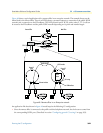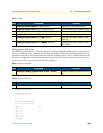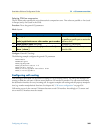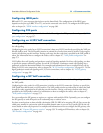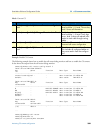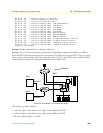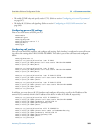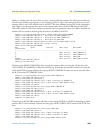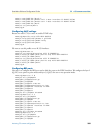
Configuring ISDN ports 348
SmartWare Software Configuration Guide 31 • CS context overview
Configuring ISDN ports
BRI and E1/T1 ports represent physical ports on the SmartNode. The configuration of the ISDN ports
depends on the port type (BRI, E1 or T1), and on the connected voice device. To configure the ISDN ports,
refer to chapter 34, “ISDN interface configuration” on page 390.
Configuring FXS ports
FXS ports represents physical ports on the SmartNode. To configure the FXS ports, refer to chapter 43, “FXS
port configuration” on page 537.
Configuring an H.323 VoIP connection
To configure a H.323 connection, you have to specify the voice codec selection used for the VoIP profile and
the call signaling.
Configuring the voice codec for an H.323 connection is done on a H.323 interface by specifying the VoIP pro-
file that shall be used. The VoIP profile contains an ordered list of codecs that must be used for codec negotia-
tion for all calls that pass this interface. During a call setup, the first codec that is specified in the VoIP profile is
taken. For information how to configure the codecs, refer to chapter 47, “VoIP profile configuration” on
page 573.
H.323 offers direct call signaling and gatekeeper routed call signaling methods. For direct call signaling, you have
to specify the remote terminal or gateway on each H.323 interface. Gatekeeper routed call signaling uses a
gatekeeper to find the destination address. For examples and information on how to configure direct call sig-
naling on H.323 voice connections, refer to chapter 38, “H.323 interface configuration” on page 431. To con-
figure gatekeeper routed call signaling on H.323 voice connections, refer to chapter 45, “H.323 gateway
configuration” on page 546.
Configuring a SIP VoIP connection
To configure a SIP connection, you have to specify the voice codec selection and the call signaling method for
the VoIP profile.
Configuring the voice codec for a SIP connection is similar to the H.323 connection. You have to specify the
VoIP profile that shall be used on a SIP interface. The VoIP profile contains an ordered list of codecs that shall
be used for codec negotiation for all calls that pass this interface. During a call setup, the first codec that is
specified in the VoIP profile is taken. For information on how to configure the codecs, refer to chapter 47,
“VoIP profile configuration” on page 573.
You can configure the SIP gateway to register to a registrar with multiple URIs. Optionally, you can configure
the SIP gateway to send all requests to an outbound proxy or redirect server.
You have several options on how to build a destination URI (To-URI) of an outgoing SIP call. You can use the
called party number in conjunction with the specified domain name or you can set a specific URI by the call
router, based on other call properties. For examples and information on how to configure the SIP gateway, refer
to chapter 46, “Context SIP gateway overview” on page 559. To configure SIP interfaces, refer to chapter 39,
“SIP interface configuration” on page 441.





